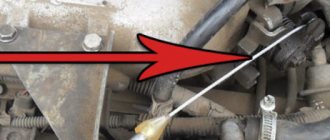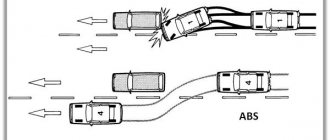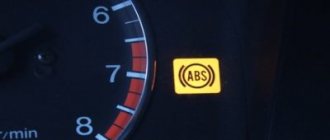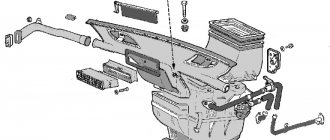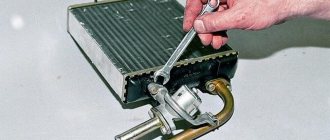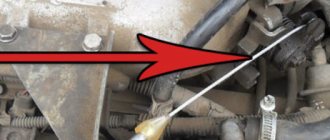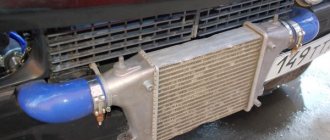Currently, all trim levels of Lada Vesta and XRAY cars, as well as “Lux” versions of Lada Granta and Kalina with AMT (robot), are equipped with a hill start assist system (HSA or HHC). It makes starting on slopes easier by holding the vehicle in place and preventing it from rolling down the slope. Let's figure out how it works and what reviews the owners of these cars leave about it.
User manual
The vehicle's owner's manual contains a description of this system, as well as short instructions on how to use it:
When stopping on an incline greater than 4%, depress the brake pedal with sufficient force to keep the vehicle stationary. When you subsequently release the brake pedal and press the accelerator pedal, the HHC function maintains hydraulic pressure in the brakes until the vehicle starts, but for no more than 2 seconds, which prevents the vehicle from rolling away.
The operation of the HHC is accompanied by a characteristic noise of the actuators. HHC does not operate when the parking brake is applied, the driver's door is open, or the ESC malfunctions.
How the anti-recoil system works on a Lada Vesta in the video:
Causes of the phenomenon
Drop in speed and failure of the gas pedal
There are few reasons for the phenomenon of “failure” when pressing the gas pedal. It often appears after unsuccessful engine chip tuning and is accompanied by an increase in fuel consumption, but there are other problems directly with injection. So, let’s look at the main reasons for the “failure” effect:
- Injectors. The fuel distribution system directly affects engine performance.
- Damage to the injector.
- The fuel supply system has failed.
- Wear of engine temperature and mixture enrichment sensors.
- Errors in the electronic engine control unit.
- Spark plug. This is the most common cause of accelerator pedal failure.
These are all the main reasons that can lead to gas pedal failure.
Dips during acceleration
Once the causes are considered, we can consider how to deal with the problem. So, let’s describe step by step what needs to be done when the gas pedal has dips during acceleration:
- The first step is to check the spark plugs. The appearance of carbon deposits or spark plugs that are too clean indicate that the mixture is not adjusted correctly. It is worth adjusting the correct amount of fuel mixture.
- Ignition wires can also cause the vehicle to malfunction.
- A clogged throttle can lead to failures during acceleration.
- The condition of the air filter affects the formation of the mixture, so it is worth changing it on time.
- The fuel pump (main faults), as well as the condition of the fuel filter, can affect injection. Therefore, in case of failures, it is necessary to diagnose them. To diagnose, you need to remove the fuel pump and check its operation, as well as the condition of the mesh filter.
- ECU errors can also lead to accelerator failures.
- The last reason is clogged injectors. They need to carry out diagnostics, check functionality, and also clean and replace faulty elements.
Thus, the causes of failures during overclocking have been identified and can be eliminated.
Gas leaks at idle
At idle, there are fewer reasons for failures, but they will have to be eliminated, since the car simply will not start normally, or stall after starting the engine. So, let's look at the work plan step by step:
- Checking the spark plugs. If the element fails, it is necessary to replace it.
Attention! It is recommended to change all four spark plugs to ensure smooth engine operation. Before installation, you should adjust the gap using a feeler gauge, which should be 1 mm for 92 gasoline
Checking and adjusting the spark plug gap using a feeler gauge
- We change the fuel filter, it is located under the bottom of the tank, and also carry out diagnostics on the fuel pump. If malfunctions are identified, they should be eliminated.
- We check the functionality of the idle speed sensor and cooling temperature.
- Fuel quality and clogged injectors also affect idle failures.
- Errors in the ECU can also cause this phenomenon.
- The performance of the injector directly affects the performance of the engine.
All these reasons can cause dips to appear at idle (more precisely, when switching from idle to driving mode).
Owner reviews
According to owner reviews, difficulties when using the anti-recoil system occur only on Lada Vesta and XRAY. The fact is that on other cars (Lada Kalina and Granta) this function is only available on trim levels with an automated transmission (AMT) . On machines with two pedals everything is simple:
- We release the brake pedal on a slope and the hill start assist system is activated (the car is held for 2-3 seconds).
- We press the gas pedal, and the car starts moving (even if you pressed the pedal before 2-3 seconds have passed).
With a manual transmission, not all drivers can get used to such an electronic assistant; they make the following comments:
- when trying to start up a hill, the car stalls due to the working recoil system;
- the system operates on a completely flat surface;
- there is no indicator informing about the operation of the system;
- there is no button to disable the recoil system (only via the ELM327 adapter);
- To prevent the system from working, you have to constantly use the handbrake.
Those who think that the system is very convenient argue that you just need to get used to it. They recommend that when starting to move uphill, press the gas a little sharper; at about 1200 ohms/min, the hill start assist system will turn off and the car will start moving without interference from the braking system.
Thus, the hill start assist system turns off immediately if you press the gas, and will not turn on if you use the handbrake. What feedback can you leave about the recoil system?
Let us remind you that we previously tested other systems of LADA cars (ABS and ESC, etc.)
To post a reply you must log in or register.
Removing and installing the gas pedal
It is necessary to immediately issue a warning: the part module is sealed. If you remove the seal and make amendments to the design yourself, the official dealer will notice this when you contact him during the warranty period and will refuse repairs under warranty, regardless of the reason for which you contact him.
To remove the pedal module, turn off the engine, remove the negative terminal from the battery and apply the handbrake. Do the following:
- Go down to the module with a flashlight and a 10mm socket (or socket) wrench.
- On the right, just above the accelerator pedal module bracket, you will find a wiring harness. Disconnect it.
- Remove the pedal module assembly.
- Reassemble in reverse order.
Posts 6
1 Topic by Ilya.Seryakov 2016-01-28 10:51:28
- Ilya.Seryakov
- Participant
- Inactive
- Posts: 27
- Thank you: 9
Topic: How does Hill Start Assist work?
On the way home from work I have one traffic light on a slight rise. When starting off without a handbrake, the old car rolled away a little. On Vesta everything happened again, I was even upset at first, I thought the assistant wasn’t working. But yesterday I checked at the exit from the underground parking, there was a wild slope, I was even scared that I wouldn’t be able to start going up the hill. But no, the system worked perfectly, I started off without the handbrake, and held the brakes for 2 seconds.
The manual, if I'm not mistaken, says that the system is activated at an elevation of 4 degrees. But this is an almost imperceptible rise. Does this work for everyone or should I complain to the dealer?
2 Reply from Petty 2016-01-28 10:53:01
- Petty
- Participant
- Inactive
- Posts: 966
- Thank you: 271
Re: How does hill start assist work?
It seems like you have to press the pedal sharply, then the system turns on, maybe that’s why it didn’t work?
3 Reply from Ilya.Seryakov 2016-01-28 11:55:56
- Ilya.Seryakov
- Participant
- Inactive
- Posts: 27
- Thank you: 9
Re: How does hill start assist work?
I'll try it one of these days, and I'll ask the manager.
4 Reply from Cd252 2016-01-28 14:26:27
- CD252
- Participant
- Inactive
- Posts: 123
- Thank you: 9
Re: How does hill start assist work?
The manual, if I'm not mistaken, says that the system is activated at an elevation of 4 degrees. But this is an almost imperceptible rise
This means that everything should work on all slopes. You just need to get used to using it.
5 Reply from falkon 2016-01-30 14:49:37
- falcon
- Participant
- Inactive
- From: Russia
- Messages: 500
- Thank you : 43
Re: How does hill start assist work?
It’s unlikely to work for everyone, but I think the system is not for everyone, it’s out of the question whether it will work or not. Now, if only the indication would be implemented.
6 Reply from Petty 2016-01-30 14:52:06 (2016-01-30 14:52:41 edited by Petty)
- Petty
- Participant
- Inactive
- Posts: 966
- Thank you: 271
Re: How does hill start assist work?
Now, if only the indication would be implemented.
Yes, a system activation light would be nice. Otherwise, it turns out that the system does not show its presence until you release the brake pedal.
Posts 6
To post a reply you must log in or register.
Forum and club of Lada Vesta owners (Lada Vesta)
Before I write my opinion about this system, perhaps I’ll write what it is...
Hill Start Assist prevents the vehicle from rolling back when starting on an incline. When the brake pedal is released while the vehicle is stationary, this system maintains brake pressure for several seconds, increasing control when starting uphill or stopping and starting on slippery surfaces.
I decided to write an opinion about this system...
I can’t help but ask: is it possible to somehow disable the hill assist system separately? Of course, I understand that such a system greatly helps drivers (especially inexperienced ones) on a climb, and does not allow them to roll back... I understand everything. Yes, maybe in ordinary flat terrain this would not be a minus, since it would work much less often. But I, who live in the mountains, don’t need it. Many will think: “What are you doing?! She really helps!”
Now I’ll explain - in my city (and its environs) there are mountains everywhere. Constantly going up or down... Dozens of times a day I start uphill, or even more: when I release the brake pedal, I smoothly release the clutch and add gas - there was no rollback even without any systems.
Now, I start to drive off as usual, but the car stops for 2 seconds! Then a small jerk (the system itself releases the pads) and the car starts moving. Moreover, such a system does not always work and you still have to guess when you need to wait a little while releasing the clutch pedal and pressing the gas, and when you need to immediately... God bless you from a traffic light, but it’s not very convenient to leave the secondary one - you have to quickly move off and pass, but it pauses for 2 seconds. I park somewhere, and she stops the car... Maybe I’m exaggerating, since I’m not yet used to the car, in particular to this system, but I immediately didn’t like it...
How the system works
This feature was originally intended for vehicles with automatic transmission and owners of such models immediately appreciated its benefits. Unfortunately, HSAs are mostly installed on premium cars and SUVs.
The system is designed to reduce the risk of getting into an emergency situation when the car starts to move on a downhill road. This is especially true when stopping at a traffic light before an intersection, on a slippery road surface. In addition to the moment of start, the system will also monitor the avoidance of skidding when moving up the road and while turning at the same time.
The hill start assist system operates approximately according to the following principle:
- The driver releases the brake pedal - HSA continues to hold the car on the brake for several minutes.
- The driver presses the gas pedal - the throttle valve opens and the car moves off.
The principle of operation of the recoil system
The basis for the operation of this function is dynamic stabilization. It is thanks to this that manufacturers have achieved reliable fixation of the vehicle on the road at a fairly large slope. But at the same time, we can say with complete confidence that this function is autonomous and can be installed on the car yourself.
The braking function is activated automatically as soon as the vehicle stops on a road with a slope of 5 degrees. These parameters are usually set by the manufacturer of this system, but the car owner has the opportunity to adjust the degree of rise of the road independently. During daily trips, a driver of such a model may decide that it will be more comfortable for him to drive a vehicle if the car reacts to a road slope of more (or less) than five degrees. Based on his own wishes, the car owner can adjust the HSA.
What is Hill Start Assist?
Hill Start Assist is a set of components whose action is aimed at preventing the car from rolling away on an inclined road.
Simplify the driver’s work when stopping on an incline (for example, before a traffic light at an intersection) and eliminate the use of the handbrake. HSA is installed on passenger cars of Russian and foreign brands.
The purpose of Hill Start Assist is to create additional braking force that will keep the car on a steep slope. In this case, the holding force occurs after the brake pedal is released.
Thanks to the action of HSA, when you move your foot from the brake pedal to the gas pedal, the car does not roll away, but is securely fixed in one place.
Such a system is a reliable assistant if you need to frequently move around the city, in off-road conditions or on mountain roads.
Novice car enthusiasts get confused by abbreviations. The reason for this phenomenon is easy to explain - each manufacturer has an individual name for HSA:
- At Volkswagen, the system discussed in the article is called Hill Hold Control (abbreviated as HHC);
- Manufacturers Fiat or Subaru have Hill Holder;
- Toyota has Hill-Start Assist Control (HAC or HSA);
- The manufacturer Nissan has Uphill Start Support (abbreviation USS).
The assistance device, which ensures that the car is fixed on a hill, is based on dynamic stabilization.
We are talking about a software extension installed on many cars. This means that Hill Start Assist is not considered an independent system.
HSA is activated automatically when the machine is parked on a slope of 5 degrees or more.
The specified angle can be adjusted in one direction or the other to achieve the greatest comfort in motion.
When the driver plans to move away, he releases the brake and then puts his foot on the gas.
When the pedal is released, the brake continues to operate until the throttle valve opens. This action prevents the car from rolling away, which increases traffic safety and comfort for the motorist.
Results
Hill Start Assist is a whole set of components, the work of which is aimed at preventing rolling away when starting to move on a road with a slope of more than 5 degrees.
The main objective of this improvement is to make the driver’s work while stopping on a hill as simple as possible and to make the use of the handbrake unnecessary.
- HSA is a very good assistant for novice car enthusiasts. Buying a vehicle with such a function by a person without driving experience is the right decision.
- If the driver has extensive driving experience, then having an HSA system is not at all necessary.
- It is also undesirable to install this function on cars with a manual transmission - it is more of a hindrance than a help.
Currently, all trim levels of Lada Vesta and XRAY cars, as well as “Lux” versions of Lada Granta and Kalina with AMT (robot), are equipped with a hill start assist system (HSA or HHC). It makes starting on slopes easier by holding the vehicle in place and preventing it from rolling down the slope. Let's figure out how it works and what reviews the owners of these cars leave about it.
What cars is it installed on?
There is some debate among car enthusiasts about which vehicles HSA is intended for. Initially it was planned for cars with an automatic transmission.
Over time, the system was improved, and it was used on different types of gearboxes (including manual ones).
The worst performing combination was the manual transmission and HSA. The reason lies in the principles of the system.
The Hill Start Assist device responds to three components - pressing the brake pedal, releasing and opening the throttle valve (pressing the accelerator pedal). The pads stop working after turning on the transmission and increasing the speed.
In the case of manual transmissions, a decrease in pressure is possible in case of over-throttle at neutral speed. As a result, the car rolls back. The driver does not expect such a trick from the device and ends up in an accident.
The reason is that Hill Start Assist is not able to clearly recognize the throttle change and the start of movement on a manual transmission.
This is why HSA in combination with “mechanics” is practically not in demand. If such a system is installed on your manual car, then you should be careful on descents, because the unit fails at an unpredictable moment.
Lada vesta electronics are being tested in Lapland
The next test drive of the Lada Vesta in winter conditions took place in Finland. For this purpose, a test site was allocated for the Nokian Tires company, in which the Russian sedan tests tires.
The subject of testing was again the exchange rate stability system, around which there is constant debate. Experienced drivers believe that ESP and ABS are only needed by beginners and are an expensive toy.
The road surface was ice. The systems had to show their effectiveness with a sharp and smooth start. In the first case, the car took longer to accelerate. When you sharply press the gas, the car quickly begins to gain momentum and the wheels slip.
A similar situation with the traction control turned off showed that with a sharp start, severe slippage occurs, leading to a loss of time. A smooth start showed the best results. An experienced driver feels the car’s behavior well and distributes the pressing forces himself.
On loose snow, the results with ESP turned on for a smooth and hard start turned out to be almost the same. Disabling the electronics allowed us to achieve the most efficient acceleration, and again, smoothly pressing the pedal greatly reduced the speed gain.
Design and principle of operation using the example of Lada Vesta
The principle of operation of Hill Start Assist on a Lada Vesta car is not very different from the general approach used on other cars.
The device works on the principle of reducing pressure in the brake system after releasing the gas pedal.
There are three components required to activate an HSA:
- The car is started;
- The brake pedal is depressed;
- The tilt angle exceeds 5% (unless another parameter has been previously set).
The device itself operates on the basis of four cycles (phases), each of which performs a specific task:
- Sufficient brake pressure is created for operation;
- Ensures that the brake pressure is maintained;
- The pressure in the brake system decreases;
- Pressure is released.
At the moment the brake is pressed (at the time of ascent), the brake system performs its functions provided that the valves (switching and inlet) are open. As a result, Hill Start Assist provides braking pressure to keep the car in one place.
After the brake is released, the switching valves close, and the required pressure is maintained in the brake circuits, which prevents the car from rolling away when the foot is moved from pedal to pedal.
As soon as the throttle valve opens (the gas pedal is depressed), the bypass valves open. This factor helps reduce brake pressure.
After the motor rotation torque reaches the required frequency, the switching valves open 100%, which guarantees pressure relief.
It is worth noting that Hill Start Assist only works on ascents. An interesting fact is that the direction of movement does not matter. So, the device will work even when driving uphill in reverse.
Hill Start Assist has become a salvation for beginners who have to drive on city streets from the first days of driving. As for experienced drivers, the presence of such a system is not necessary for them. In addition, when buying a car with a manual transmission, HAS brings more headaches than real benefits.
So you should think about whether it’s worth paying extra for such an option or not.
Route map for identifying causes
Incorrect determination by the computer of the volume of air supplied to the combustion chamber, problems with the ignition system and an additional flow of gasoline vapor into the intake manifold of the Lada Vesta cause engine vibration at idle speed and operating modes. There are many reasons, so diagnosis should be done progressively. Check:
- Presence of air leaks in the intake pipe.
- The operation of the vacuum brake booster and the integrity of the connection between the tube and the input manifold.
- Canister valve.
- Throttle position sensors, absolute pressure and temperature sensors, idle air control.
- Integrity of wires and serviceability of ignition system coils.
I began to observe such a problem. Sometimes there is a drop in power, that is, you can’t get into FIRST until it slips (even with ESP turned off!), but if you turn off the engine and start it again, there is a possibility that the dynamics will return, the problem is floating and I don’t understand at all what does it depend on.upd: I am inclined to think that the pedal is naughty.
upd: The switched-on speed limiter is to blame, it chokes the engine throughout the entire speed range, turn it off and everything is fine!
In order for the car to comply with more stringent environmental standards, AvtoVAZ equips modern Lada cars (Priora, Granta, Kalina, Niva, Largus, Vesta and XRAY) with an electronic gas pedal or “E-gas”. The throttle valve drive got rid of the cable and became equipped with a gear motor. As a result, the gas pedal has no mechanical connection with the throttle valve, and engine control has become completely electronic.
